Workflow Management: Analyzing Supreme Dry Cleaners' IT Challenges
VerifiedAdded on 2023/06/04
|12
|3026
|464
Case Study
AI Summary
This case study examines the workflow management challenges at Supreme Dry Cleaners (SDC), a family-run business with multiple locations. It highlights the importance of teamwork, effective communication, and the benefits of having an IT department. The analysis covers characteristics of effective teamwork, advantages and disadvantages of teamwork, essential communication skills, recent communication tools, and the roles of an IT department in data management, big data analysis, and IT infrastructure maintenance. It also addresses challenges involving IT such as security risks, rapid technological changes, and high costs. The study recommends enhancing teamwork and communication skills, adopting collaborative technologies, and incorporating an IT department to improve efficiency and management of operations, suggesting process mapping and fail-surfing methodologies for continuous improvement. Furthermore, it proposes the implementation of ERP systems to automate and centralize all operations.
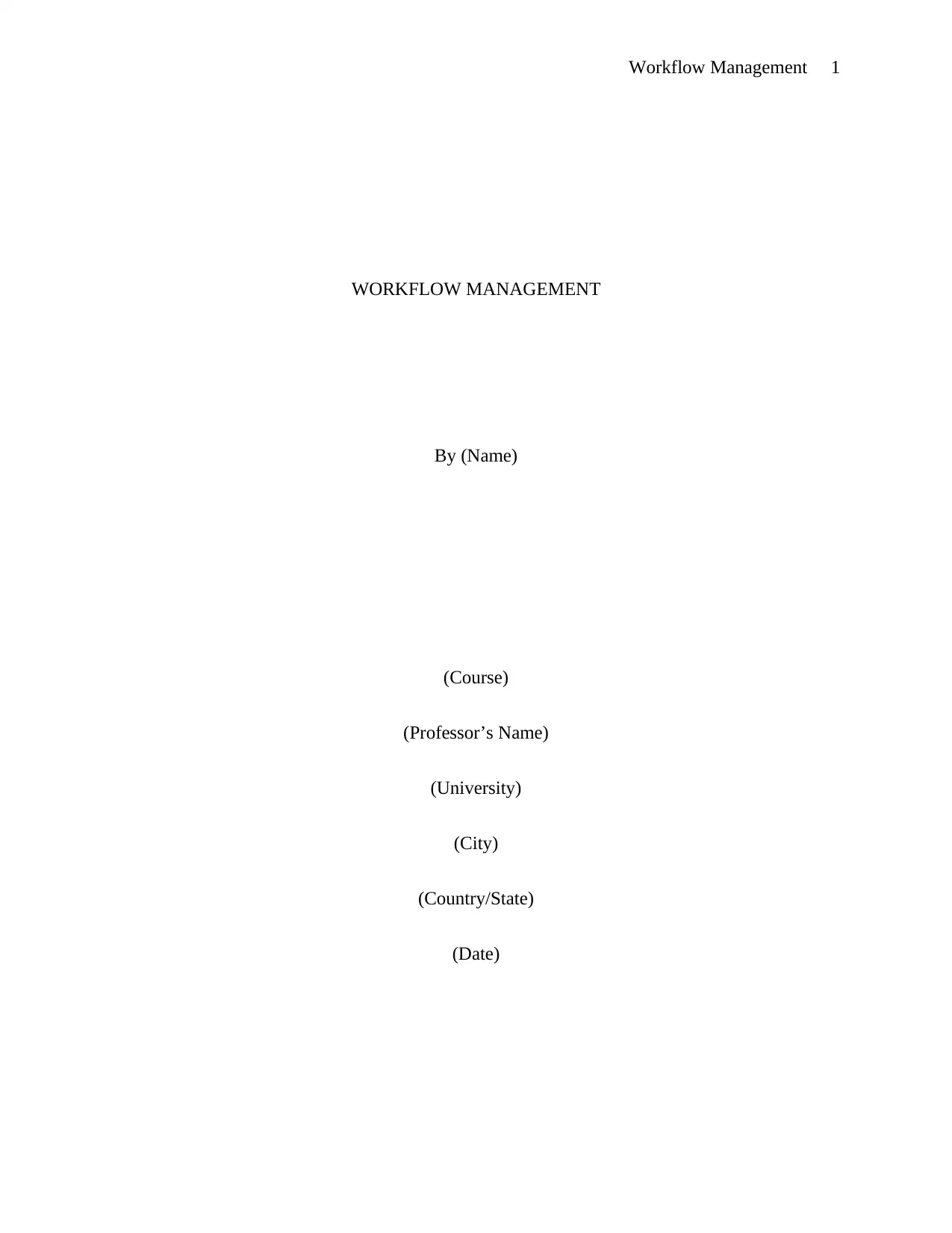
Workflow Management 1
WORKFLOW MANAGEMENT
By (Name)
(Course)
(Professor’s Name)
(University)
(City)
(Country/State)
(Date)
WORKFLOW MANAGEMENT
By (Name)
(Course)
(Professor’s Name)
(University)
(City)
(Country/State)
(Date)
Paraphrase This Document
Need a fresh take? Get an instant paraphrase of this document with our AI Paraphraser
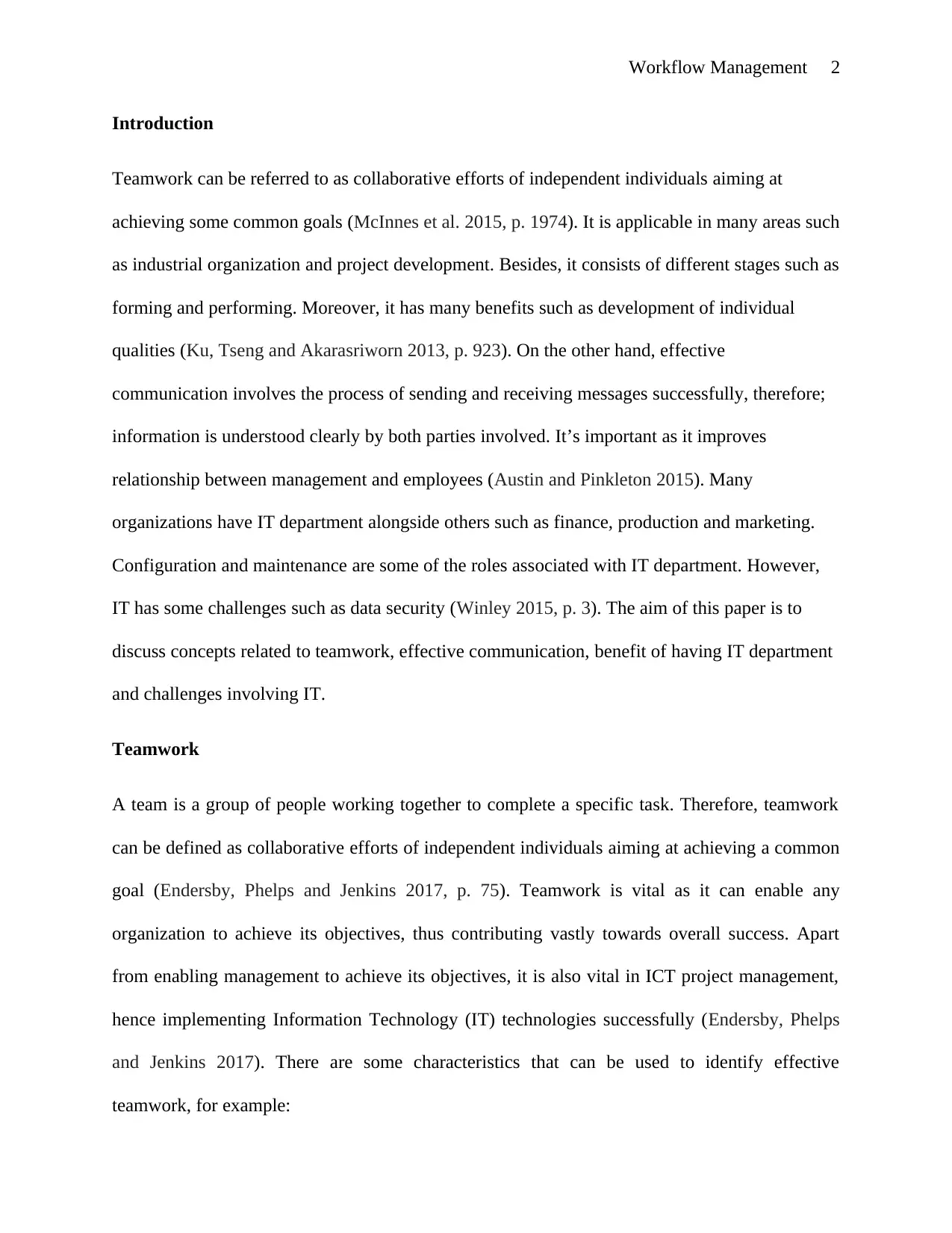
Workflow Management 2
Introduction
Teamwork can be referred to as collaborative efforts of independent individuals aiming at
achieving some common goals (McInnes et al. 2015, p. 1974). It is applicable in many areas such
as industrial organization and project development. Besides, it consists of different stages such as
forming and performing. Moreover, it has many benefits such as development of individual
qualities (Ku, Tseng and Akarasriworn 2013, p. 923). On the other hand, effective
communication involves the process of sending and receiving messages successfully, therefore;
information is understood clearly by both parties involved. It’s important as it improves
relationship between management and employees (Austin and Pinkleton 2015). Many
organizations have IT department alongside others such as finance, production and marketing.
Configuration and maintenance are some of the roles associated with IT department. However,
IT has some challenges such as data security (Winley 2015, p. 3). The aim of this paper is to
discuss concepts related to teamwork, effective communication, benefit of having IT department
and challenges involving IT.
Teamwork
A team is a group of people working together to complete a specific task. Therefore, teamwork
can be defined as collaborative efforts of independent individuals aiming at achieving a common
goal (Endersby, Phelps and Jenkins 2017, p. 75). Teamwork is vital as it can enable any
organization to achieve its objectives, thus contributing vastly towards overall success. Apart
from enabling management to achieve its objectives, it is also vital in ICT project management,
hence implementing Information Technology (IT) technologies successfully (Endersby, Phelps
and Jenkins 2017). There are some characteristics that can be used to identify effective
teamwork, for example:
Introduction
Teamwork can be referred to as collaborative efforts of independent individuals aiming at
achieving some common goals (McInnes et al. 2015, p. 1974). It is applicable in many areas such
as industrial organization and project development. Besides, it consists of different stages such as
forming and performing. Moreover, it has many benefits such as development of individual
qualities (Ku, Tseng and Akarasriworn 2013, p. 923). On the other hand, effective
communication involves the process of sending and receiving messages successfully, therefore;
information is understood clearly by both parties involved. It’s important as it improves
relationship between management and employees (Austin and Pinkleton 2015). Many
organizations have IT department alongside others such as finance, production and marketing.
Configuration and maintenance are some of the roles associated with IT department. However,
IT has some challenges such as data security (Winley 2015, p. 3). The aim of this paper is to
discuss concepts related to teamwork, effective communication, benefit of having IT department
and challenges involving IT.
Teamwork
A team is a group of people working together to complete a specific task. Therefore, teamwork
can be defined as collaborative efforts of independent individuals aiming at achieving a common
goal (Endersby, Phelps and Jenkins 2017, p. 75). Teamwork is vital as it can enable any
organization to achieve its objectives, thus contributing vastly towards overall success. Apart
from enabling management to achieve its objectives, it is also vital in ICT project management,
hence implementing Information Technology (IT) technologies successfully (Endersby, Phelps
and Jenkins 2017). There are some characteristics that can be used to identify effective
teamwork, for example:
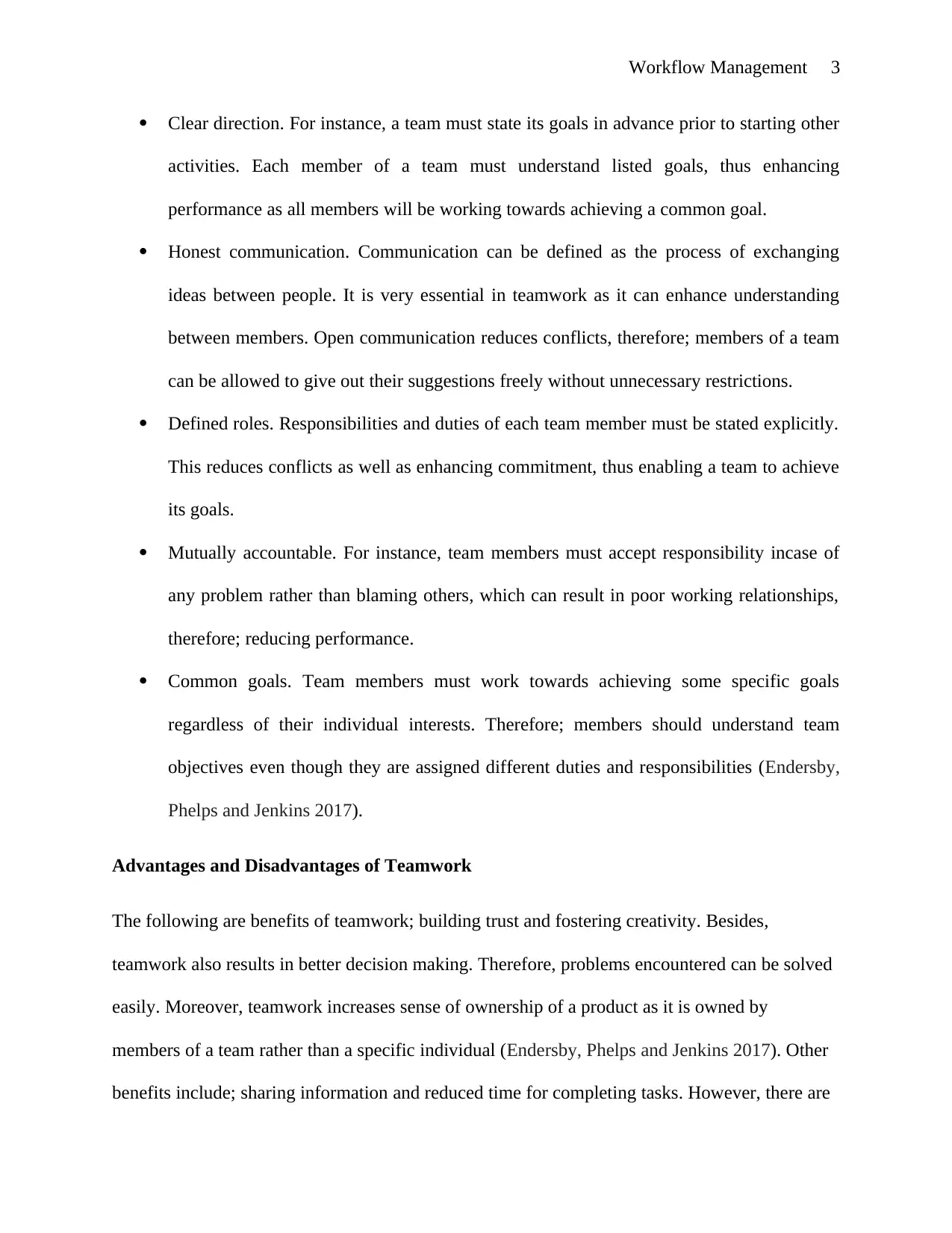
Workflow Management 3
Clear direction. For instance, a team must state its goals in advance prior to starting other
activities. Each member of a team must understand listed goals, thus enhancing
performance as all members will be working towards achieving a common goal.
Honest communication. Communication can be defined as the process of exchanging
ideas between people. It is very essential in teamwork as it can enhance understanding
between members. Open communication reduces conflicts, therefore; members of a team
can be allowed to give out their suggestions freely without unnecessary restrictions.
Defined roles. Responsibilities and duties of each team member must be stated explicitly.
This reduces conflicts as well as enhancing commitment, thus enabling a team to achieve
its goals.
Mutually accountable. For instance, team members must accept responsibility incase of
any problem rather than blaming others, which can result in poor working relationships,
therefore; reducing performance.
Common goals. Team members must work towards achieving some specific goals
regardless of their individual interests. Therefore; members should understand team
objectives even though they are assigned different duties and responsibilities (Endersby,
Phelps and Jenkins 2017).
Advantages and Disadvantages of Teamwork
The following are benefits of teamwork; building trust and fostering creativity. Besides,
teamwork also results in better decision making. Therefore, problems encountered can be solved
easily. Moreover, teamwork increases sense of ownership of a product as it is owned by
members of a team rather than a specific individual (Endersby, Phelps and Jenkins 2017). Other
benefits include; sharing information and reduced time for completing tasks. However, there are
Clear direction. For instance, a team must state its goals in advance prior to starting other
activities. Each member of a team must understand listed goals, thus enhancing
performance as all members will be working towards achieving a common goal.
Honest communication. Communication can be defined as the process of exchanging
ideas between people. It is very essential in teamwork as it can enhance understanding
between members. Open communication reduces conflicts, therefore; members of a team
can be allowed to give out their suggestions freely without unnecessary restrictions.
Defined roles. Responsibilities and duties of each team member must be stated explicitly.
This reduces conflicts as well as enhancing commitment, thus enabling a team to achieve
its goals.
Mutually accountable. For instance, team members must accept responsibility incase of
any problem rather than blaming others, which can result in poor working relationships,
therefore; reducing performance.
Common goals. Team members must work towards achieving some specific goals
regardless of their individual interests. Therefore; members should understand team
objectives even though they are assigned different duties and responsibilities (Endersby,
Phelps and Jenkins 2017).
Advantages and Disadvantages of Teamwork
The following are benefits of teamwork; building trust and fostering creativity. Besides,
teamwork also results in better decision making. Therefore, problems encountered can be solved
easily. Moreover, teamwork increases sense of ownership of a product as it is owned by
members of a team rather than a specific individual (Endersby, Phelps and Jenkins 2017). Other
benefits include; sharing information and reduced time for completing tasks. However, there are
⊘ This is a preview!⊘
Do you want full access?
Subscribe today to unlock all pages.

Trusted by 1+ million students worldwide
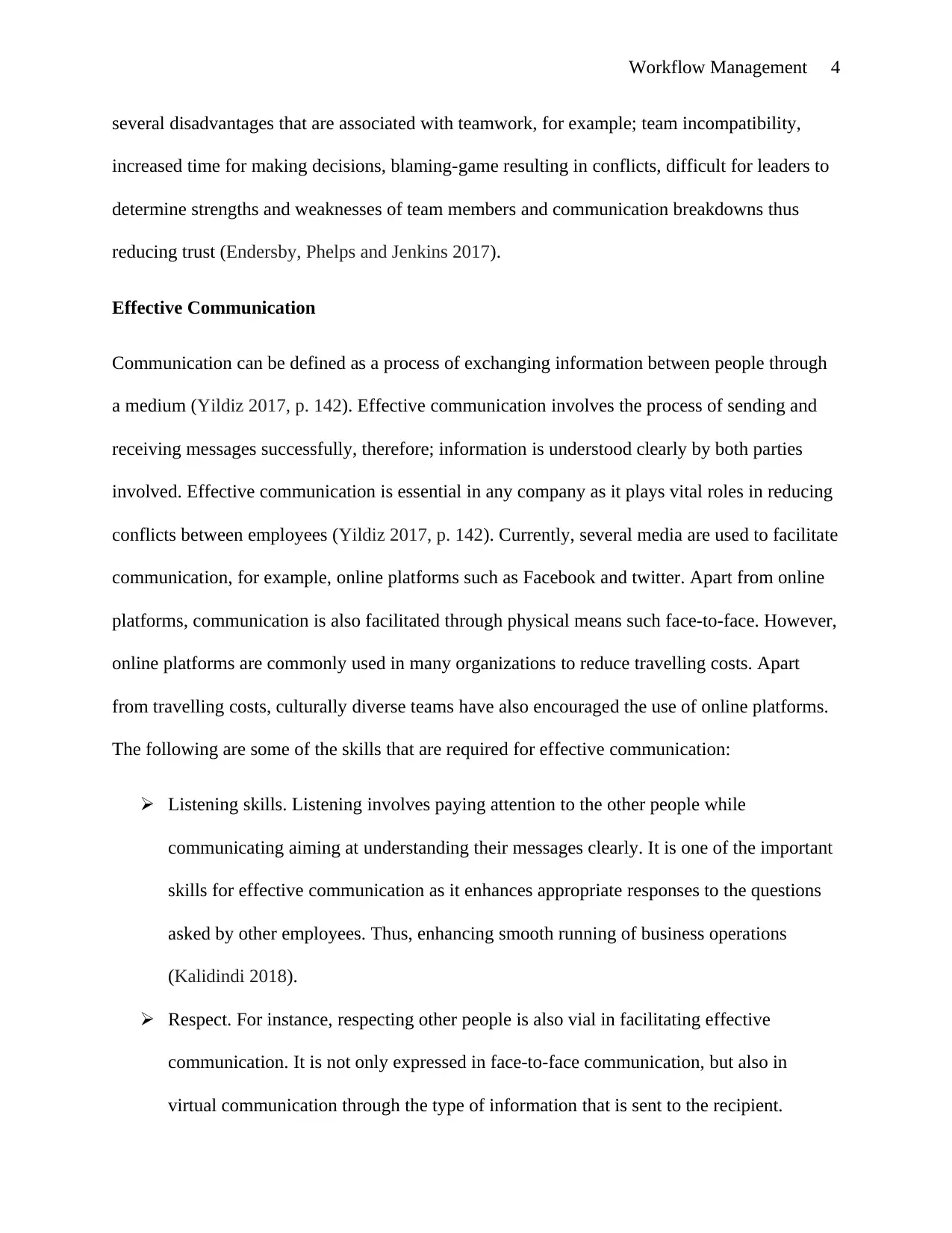
Workflow Management 4
several disadvantages that are associated with teamwork, for example; team incompatibility,
increased time for making decisions, blaming-game resulting in conflicts, difficult for leaders to
determine strengths and weaknesses of team members and communication breakdowns thus
reducing trust (Endersby, Phelps and Jenkins 2017).
Effective Communication
Communication can be defined as a process of exchanging information between people through
a medium (Yildiz 2017, p. 142). Effective communication involves the process of sending and
receiving messages successfully, therefore; information is understood clearly by both parties
involved. Effective communication is essential in any company as it plays vital roles in reducing
conflicts between employees (Yildiz 2017, p. 142). Currently, several media are used to facilitate
communication, for example, online platforms such as Facebook and twitter. Apart from online
platforms, communication is also facilitated through physical means such face-to-face. However,
online platforms are commonly used in many organizations to reduce travelling costs. Apart
from travelling costs, culturally diverse teams have also encouraged the use of online platforms.
The following are some of the skills that are required for effective communication:
Listening skills. Listening involves paying attention to the other people while
communicating aiming at understanding their messages clearly. It is one of the important
skills for effective communication as it enhances appropriate responses to the questions
asked by other employees. Thus, enhancing smooth running of business operations
(Kalidindi 2018).
Respect. For instance, respecting other people is also vial in facilitating effective
communication. It is not only expressed in face-to-face communication, but also in
virtual communication through the type of information that is sent to the recipient.
several disadvantages that are associated with teamwork, for example; team incompatibility,
increased time for making decisions, blaming-game resulting in conflicts, difficult for leaders to
determine strengths and weaknesses of team members and communication breakdowns thus
reducing trust (Endersby, Phelps and Jenkins 2017).
Effective Communication
Communication can be defined as a process of exchanging information between people through
a medium (Yildiz 2017, p. 142). Effective communication involves the process of sending and
receiving messages successfully, therefore; information is understood clearly by both parties
involved. Effective communication is essential in any company as it plays vital roles in reducing
conflicts between employees (Yildiz 2017, p. 142). Currently, several media are used to facilitate
communication, for example, online platforms such as Facebook and twitter. Apart from online
platforms, communication is also facilitated through physical means such face-to-face. However,
online platforms are commonly used in many organizations to reduce travelling costs. Apart
from travelling costs, culturally diverse teams have also encouraged the use of online platforms.
The following are some of the skills that are required for effective communication:
Listening skills. Listening involves paying attention to the other people while
communicating aiming at understanding their messages clearly. It is one of the important
skills for effective communication as it enhances appropriate responses to the questions
asked by other employees. Thus, enhancing smooth running of business operations
(Kalidindi 2018).
Respect. For instance, respecting other people is also vial in facilitating effective
communication. It is not only expressed in face-to-face communication, but also in
virtual communication through the type of information that is sent to the recipient.
Paraphrase This Document
Need a fresh take? Get an instant paraphrase of this document with our AI Paraphraser
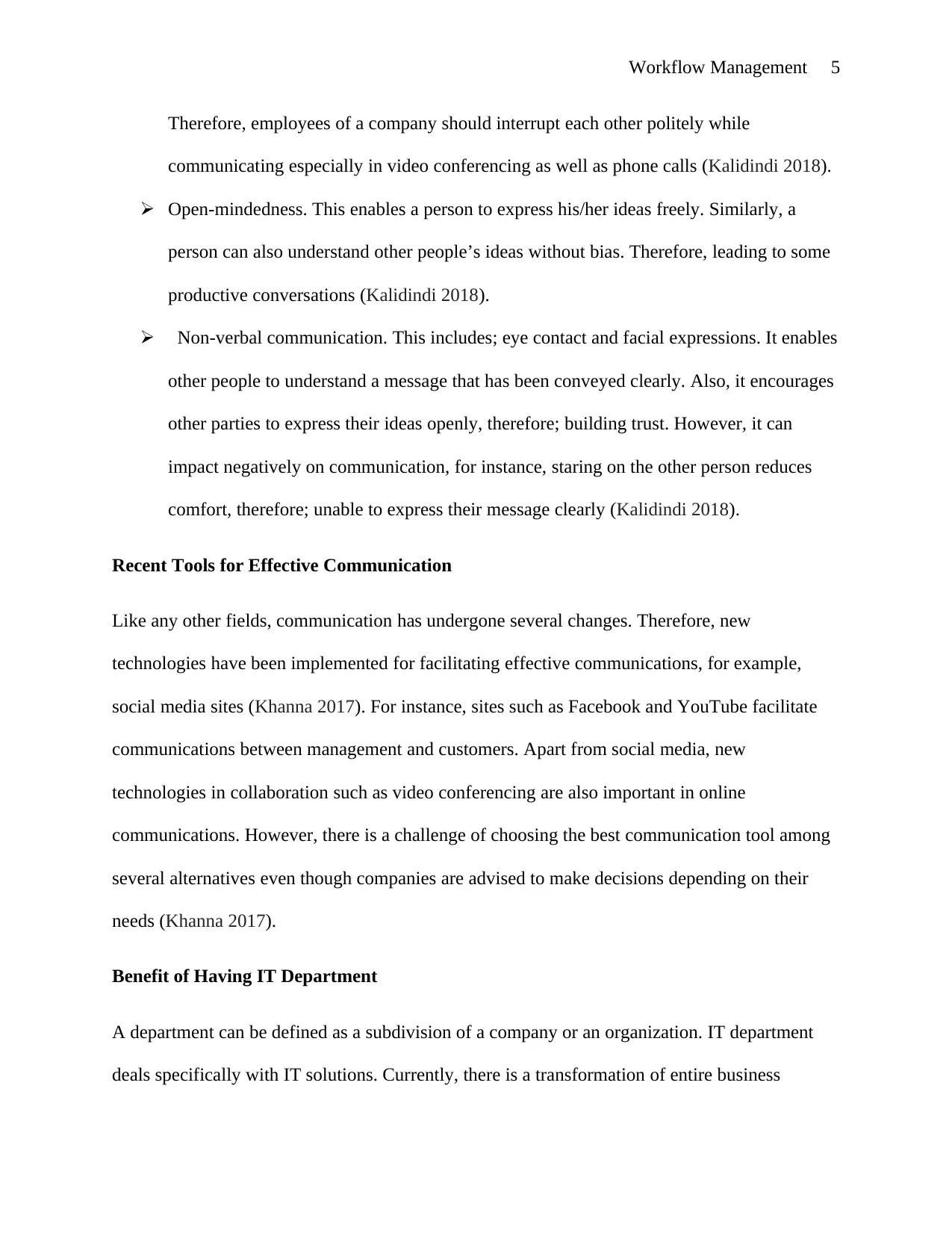
Workflow Management 5
Therefore, employees of a company should interrupt each other politely while
communicating especially in video conferencing as well as phone calls (Kalidindi 2018).
Open-mindedness. This enables a person to express his/her ideas freely. Similarly, a
person can also understand other people’s ideas without bias. Therefore, leading to some
productive conversations (Kalidindi 2018).
Non-verbal communication. This includes; eye contact and facial expressions. It enables
other people to understand a message that has been conveyed clearly. Also, it encourages
other parties to express their ideas openly, therefore; building trust. However, it can
impact negatively on communication, for instance, staring on the other person reduces
comfort, therefore; unable to express their message clearly (Kalidindi 2018).
Recent Tools for Effective Communication
Like any other fields, communication has undergone several changes. Therefore, new
technologies have been implemented for facilitating effective communications, for example,
social media sites (Khanna 2017). For instance, sites such as Facebook and YouTube facilitate
communications between management and customers. Apart from social media, new
technologies in collaboration such as video conferencing are also important in online
communications. However, there is a challenge of choosing the best communication tool among
several alternatives even though companies are advised to make decisions depending on their
needs (Khanna 2017).
Benefit of Having IT Department
A department can be defined as a subdivision of a company or an organization. IT department
deals specifically with IT solutions. Currently, there is a transformation of entire business
Therefore, employees of a company should interrupt each other politely while
communicating especially in video conferencing as well as phone calls (Kalidindi 2018).
Open-mindedness. This enables a person to express his/her ideas freely. Similarly, a
person can also understand other people’s ideas without bias. Therefore, leading to some
productive conversations (Kalidindi 2018).
Non-verbal communication. This includes; eye contact and facial expressions. It enables
other people to understand a message that has been conveyed clearly. Also, it encourages
other parties to express their ideas openly, therefore; building trust. However, it can
impact negatively on communication, for instance, staring on the other person reduces
comfort, therefore; unable to express their message clearly (Kalidindi 2018).
Recent Tools for Effective Communication
Like any other fields, communication has undergone several changes. Therefore, new
technologies have been implemented for facilitating effective communications, for example,
social media sites (Khanna 2017). For instance, sites such as Facebook and YouTube facilitate
communications between management and customers. Apart from social media, new
technologies in collaboration such as video conferencing are also important in online
communications. However, there is a challenge of choosing the best communication tool among
several alternatives even though companies are advised to make decisions depending on their
needs (Khanna 2017).
Benefit of Having IT Department
A department can be defined as a subdivision of a company or an organization. IT department
deals specifically with IT solutions. Currently, there is a transformation of entire business
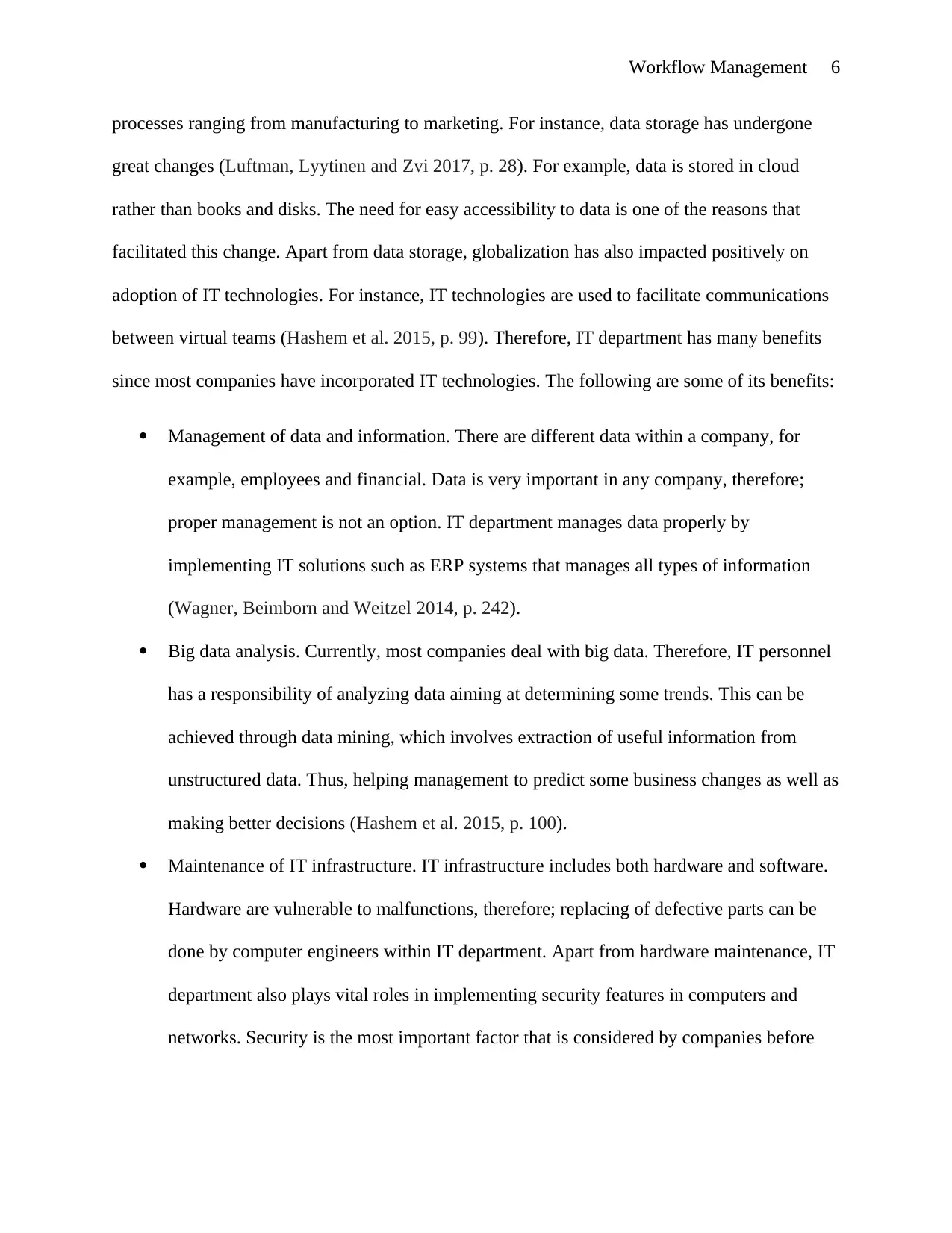
Workflow Management 6
processes ranging from manufacturing to marketing. For instance, data storage has undergone
great changes (Luftman, Lyytinen and Zvi 2017, p. 28). For example, data is stored in cloud
rather than books and disks. The need for easy accessibility to data is one of the reasons that
facilitated this change. Apart from data storage, globalization has also impacted positively on
adoption of IT technologies. For instance, IT technologies are used to facilitate communications
between virtual teams (Hashem et al. 2015, p. 99). Therefore, IT department has many benefits
since most companies have incorporated IT technologies. The following are some of its benefits:
Management of data and information. There are different data within a company, for
example, employees and financial. Data is very important in any company, therefore;
proper management is not an option. IT department manages data properly by
implementing IT solutions such as ERP systems that manages all types of information
(Wagner, Beimborn and Weitzel 2014, p. 242).
Big data analysis. Currently, most companies deal with big data. Therefore, IT personnel
has a responsibility of analyzing data aiming at determining some trends. This can be
achieved through data mining, which involves extraction of useful information from
unstructured data. Thus, helping management to predict some business changes as well as
making better decisions (Hashem et al. 2015, p. 100).
Maintenance of IT infrastructure. IT infrastructure includes both hardware and software.
Hardware are vulnerable to malfunctions, therefore; replacing of defective parts can be
done by computer engineers within IT department. Apart from hardware maintenance, IT
department also plays vital roles in implementing security features in computers and
networks. Security is the most important factor that is considered by companies before
processes ranging from manufacturing to marketing. For instance, data storage has undergone
great changes (Luftman, Lyytinen and Zvi 2017, p. 28). For example, data is stored in cloud
rather than books and disks. The need for easy accessibility to data is one of the reasons that
facilitated this change. Apart from data storage, globalization has also impacted positively on
adoption of IT technologies. For instance, IT technologies are used to facilitate communications
between virtual teams (Hashem et al. 2015, p. 99). Therefore, IT department has many benefits
since most companies have incorporated IT technologies. The following are some of its benefits:
Management of data and information. There are different data within a company, for
example, employees and financial. Data is very important in any company, therefore;
proper management is not an option. IT department manages data properly by
implementing IT solutions such as ERP systems that manages all types of information
(Wagner, Beimborn and Weitzel 2014, p. 242).
Big data analysis. Currently, most companies deal with big data. Therefore, IT personnel
has a responsibility of analyzing data aiming at determining some trends. This can be
achieved through data mining, which involves extraction of useful information from
unstructured data. Thus, helping management to predict some business changes as well as
making better decisions (Hashem et al. 2015, p. 100).
Maintenance of IT infrastructure. IT infrastructure includes both hardware and software.
Hardware are vulnerable to malfunctions, therefore; replacing of defective parts can be
done by computer engineers within IT department. Apart from hardware maintenance, IT
department also plays vital roles in implementing security features in computers and
networks. Security is the most important factor that is considered by companies before
⊘ This is a preview!⊘
Do you want full access?
Subscribe today to unlock all pages.

Trusted by 1+ million students worldwide
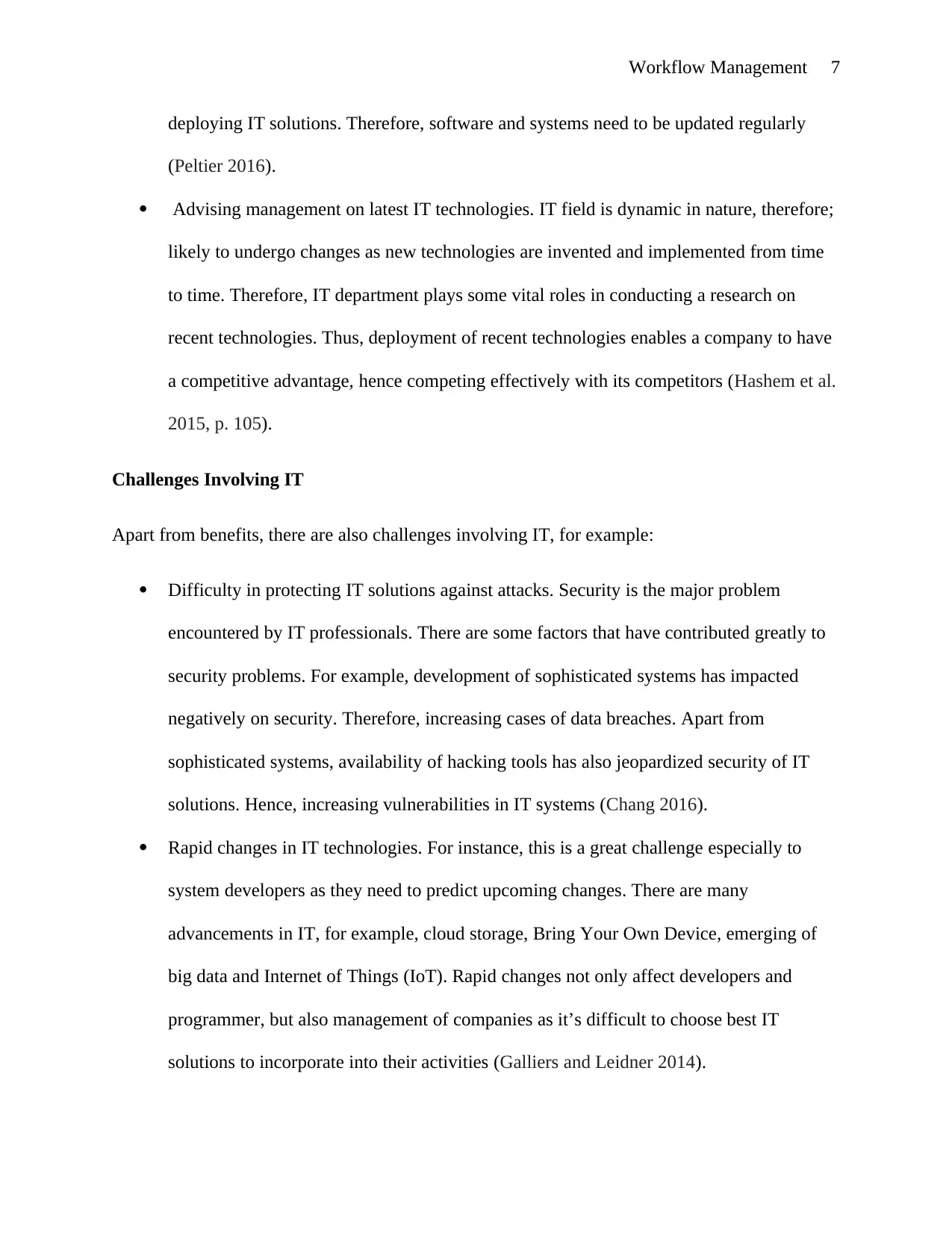
Workflow Management 7
deploying IT solutions. Therefore, software and systems need to be updated regularly
(Peltier 2016).
Advising management on latest IT technologies. IT field is dynamic in nature, therefore;
likely to undergo changes as new technologies are invented and implemented from time
to time. Therefore, IT department plays some vital roles in conducting a research on
recent technologies. Thus, deployment of recent technologies enables a company to have
a competitive advantage, hence competing effectively with its competitors (Hashem et al.
2015, p. 105).
Challenges Involving IT
Apart from benefits, there are also challenges involving IT, for example:
Difficulty in protecting IT solutions against attacks. Security is the major problem
encountered by IT professionals. There are some factors that have contributed greatly to
security problems. For example, development of sophisticated systems has impacted
negatively on security. Therefore, increasing cases of data breaches. Apart from
sophisticated systems, availability of hacking tools has also jeopardized security of IT
solutions. Hence, increasing vulnerabilities in IT systems (Chang 2016).
Rapid changes in IT technologies. For instance, this is a great challenge especially to
system developers as they need to predict upcoming changes. There are many
advancements in IT, for example, cloud storage, Bring Your Own Device, emerging of
big data and Internet of Things (IoT). Rapid changes not only affect developers and
programmer, but also management of companies as it’s difficult to choose best IT
solutions to incorporate into their activities (Galliers and Leidner 2014).
deploying IT solutions. Therefore, software and systems need to be updated regularly
(Peltier 2016).
Advising management on latest IT technologies. IT field is dynamic in nature, therefore;
likely to undergo changes as new technologies are invented and implemented from time
to time. Therefore, IT department plays some vital roles in conducting a research on
recent technologies. Thus, deployment of recent technologies enables a company to have
a competitive advantage, hence competing effectively with its competitors (Hashem et al.
2015, p. 105).
Challenges Involving IT
Apart from benefits, there are also challenges involving IT, for example:
Difficulty in protecting IT solutions against attacks. Security is the major problem
encountered by IT professionals. There are some factors that have contributed greatly to
security problems. For example, development of sophisticated systems has impacted
negatively on security. Therefore, increasing cases of data breaches. Apart from
sophisticated systems, availability of hacking tools has also jeopardized security of IT
solutions. Hence, increasing vulnerabilities in IT systems (Chang 2016).
Rapid changes in IT technologies. For instance, this is a great challenge especially to
system developers as they need to predict upcoming changes. There are many
advancements in IT, for example, cloud storage, Bring Your Own Device, emerging of
big data and Internet of Things (IoT). Rapid changes not only affect developers and
programmer, but also management of companies as it’s difficult to choose best IT
solutions to incorporate into their activities (Galliers and Leidner 2014).
Paraphrase This Document
Need a fresh take? Get an instant paraphrase of this document with our AI Paraphraser
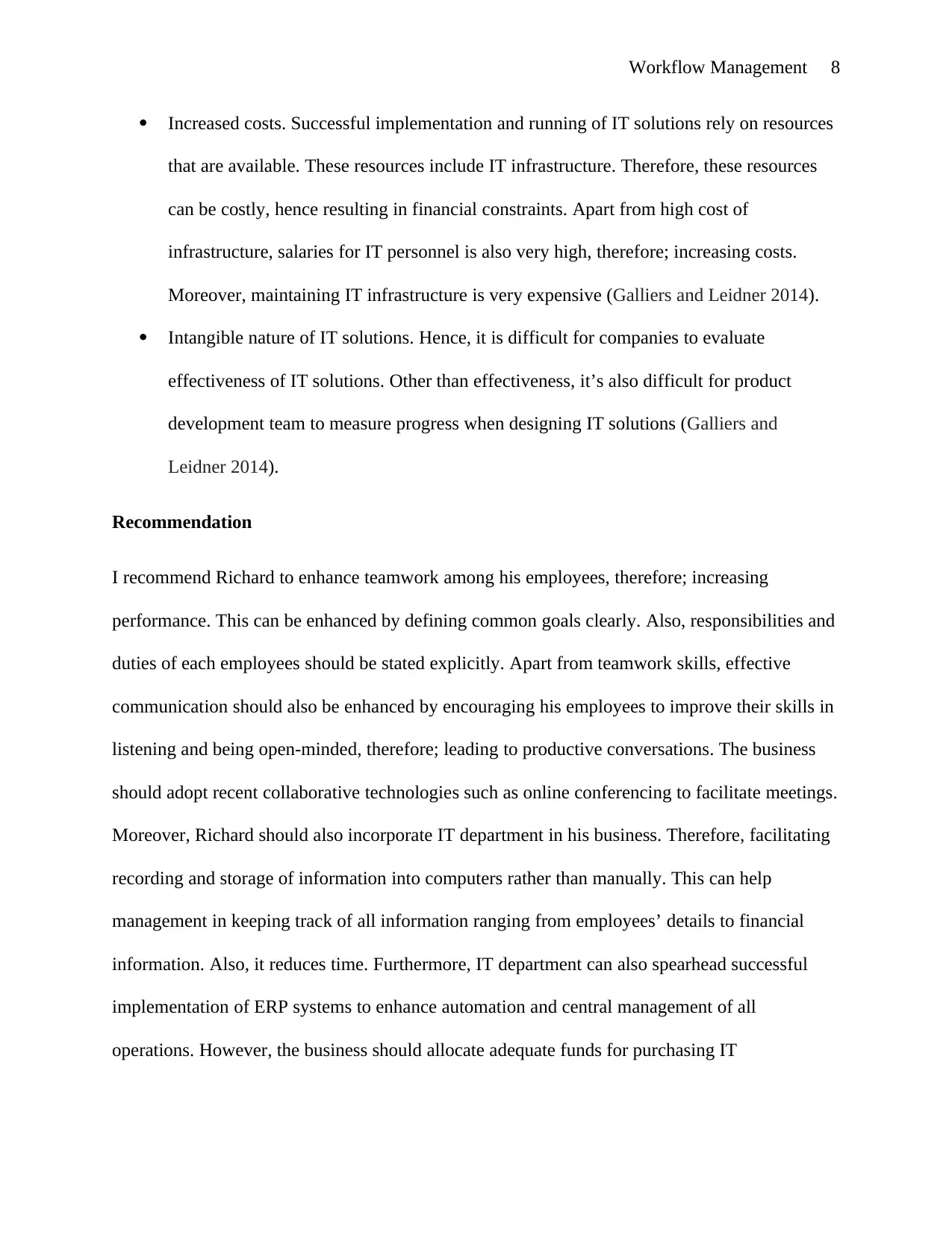
Workflow Management 8
Increased costs. Successful implementation and running of IT solutions rely on resources
that are available. These resources include IT infrastructure. Therefore, these resources
can be costly, hence resulting in financial constraints. Apart from high cost of
infrastructure, salaries for IT personnel is also very high, therefore; increasing costs.
Moreover, maintaining IT infrastructure is very expensive (Galliers and Leidner 2014).
Intangible nature of IT solutions. Hence, it is difficult for companies to evaluate
effectiveness of IT solutions. Other than effectiveness, it’s also difficult for product
development team to measure progress when designing IT solutions (Galliers and
Leidner 2014).
Recommendation
I recommend Richard to enhance teamwork among his employees, therefore; increasing
performance. This can be enhanced by defining common goals clearly. Also, responsibilities and
duties of each employees should be stated explicitly. Apart from teamwork skills, effective
communication should also be enhanced by encouraging his employees to improve their skills in
listening and being open-minded, therefore; leading to productive conversations. The business
should adopt recent collaborative technologies such as online conferencing to facilitate meetings.
Moreover, Richard should also incorporate IT department in his business. Therefore, facilitating
recording and storage of information into computers rather than manually. This can help
management in keeping track of all information ranging from employees’ details to financial
information. Also, it reduces time. Furthermore, IT department can also spearhead successful
implementation of ERP systems to enhance automation and central management of all
operations. However, the business should allocate adequate funds for purchasing IT
Increased costs. Successful implementation and running of IT solutions rely on resources
that are available. These resources include IT infrastructure. Therefore, these resources
can be costly, hence resulting in financial constraints. Apart from high cost of
infrastructure, salaries for IT personnel is also very high, therefore; increasing costs.
Moreover, maintaining IT infrastructure is very expensive (Galliers and Leidner 2014).
Intangible nature of IT solutions. Hence, it is difficult for companies to evaluate
effectiveness of IT solutions. Other than effectiveness, it’s also difficult for product
development team to measure progress when designing IT solutions (Galliers and
Leidner 2014).
Recommendation
I recommend Richard to enhance teamwork among his employees, therefore; increasing
performance. This can be enhanced by defining common goals clearly. Also, responsibilities and
duties of each employees should be stated explicitly. Apart from teamwork skills, effective
communication should also be enhanced by encouraging his employees to improve their skills in
listening and being open-minded, therefore; leading to productive conversations. The business
should adopt recent collaborative technologies such as online conferencing to facilitate meetings.
Moreover, Richard should also incorporate IT department in his business. Therefore, facilitating
recording and storage of information into computers rather than manually. This can help
management in keeping track of all information ranging from employees’ details to financial
information. Also, it reduces time. Furthermore, IT department can also spearhead successful
implementation of ERP systems to enhance automation and central management of all
operations. However, the business should allocate adequate funds for purchasing IT
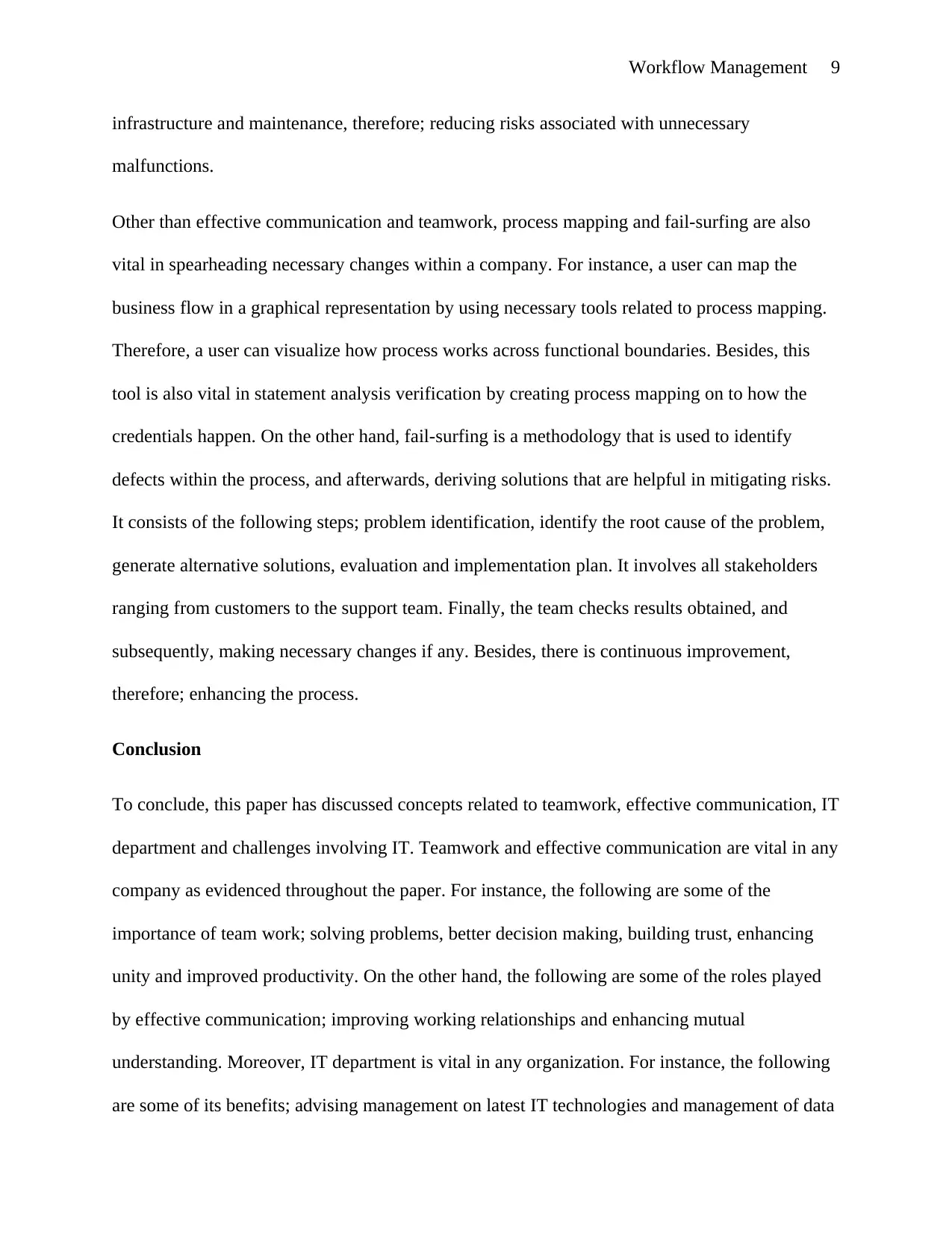
Workflow Management 9
infrastructure and maintenance, therefore; reducing risks associated with unnecessary
malfunctions.
Other than effective communication and teamwork, process mapping and fail-surfing are also
vital in spearheading necessary changes within a company. For instance, a user can map the
business flow in a graphical representation by using necessary tools related to process mapping.
Therefore, a user can visualize how process works across functional boundaries. Besides, this
tool is also vital in statement analysis verification by creating process mapping on to how the
credentials happen. On the other hand, fail-surfing is a methodology that is used to identify
defects within the process, and afterwards, deriving solutions that are helpful in mitigating risks.
It consists of the following steps; problem identification, identify the root cause of the problem,
generate alternative solutions, evaluation and implementation plan. It involves all stakeholders
ranging from customers to the support team. Finally, the team checks results obtained, and
subsequently, making necessary changes if any. Besides, there is continuous improvement,
therefore; enhancing the process.
Conclusion
To conclude, this paper has discussed concepts related to teamwork, effective communication, IT
department and challenges involving IT. Teamwork and effective communication are vital in any
company as evidenced throughout the paper. For instance, the following are some of the
importance of team work; solving problems, better decision making, building trust, enhancing
unity and improved productivity. On the other hand, the following are some of the roles played
by effective communication; improving working relationships and enhancing mutual
understanding. Moreover, IT department is vital in any organization. For instance, the following
are some of its benefits; advising management on latest IT technologies and management of data
infrastructure and maintenance, therefore; reducing risks associated with unnecessary
malfunctions.
Other than effective communication and teamwork, process mapping and fail-surfing are also
vital in spearheading necessary changes within a company. For instance, a user can map the
business flow in a graphical representation by using necessary tools related to process mapping.
Therefore, a user can visualize how process works across functional boundaries. Besides, this
tool is also vital in statement analysis verification by creating process mapping on to how the
credentials happen. On the other hand, fail-surfing is a methodology that is used to identify
defects within the process, and afterwards, deriving solutions that are helpful in mitigating risks.
It consists of the following steps; problem identification, identify the root cause of the problem,
generate alternative solutions, evaluation and implementation plan. It involves all stakeholders
ranging from customers to the support team. Finally, the team checks results obtained, and
subsequently, making necessary changes if any. Besides, there is continuous improvement,
therefore; enhancing the process.
Conclusion
To conclude, this paper has discussed concepts related to teamwork, effective communication, IT
department and challenges involving IT. Teamwork and effective communication are vital in any
company as evidenced throughout the paper. For instance, the following are some of the
importance of team work; solving problems, better decision making, building trust, enhancing
unity and improved productivity. On the other hand, the following are some of the roles played
by effective communication; improving working relationships and enhancing mutual
understanding. Moreover, IT department is vital in any organization. For instance, the following
are some of its benefits; advising management on latest IT technologies and management of data
⊘ This is a preview!⊘
Do you want full access?
Subscribe today to unlock all pages.

Trusted by 1+ million students worldwide
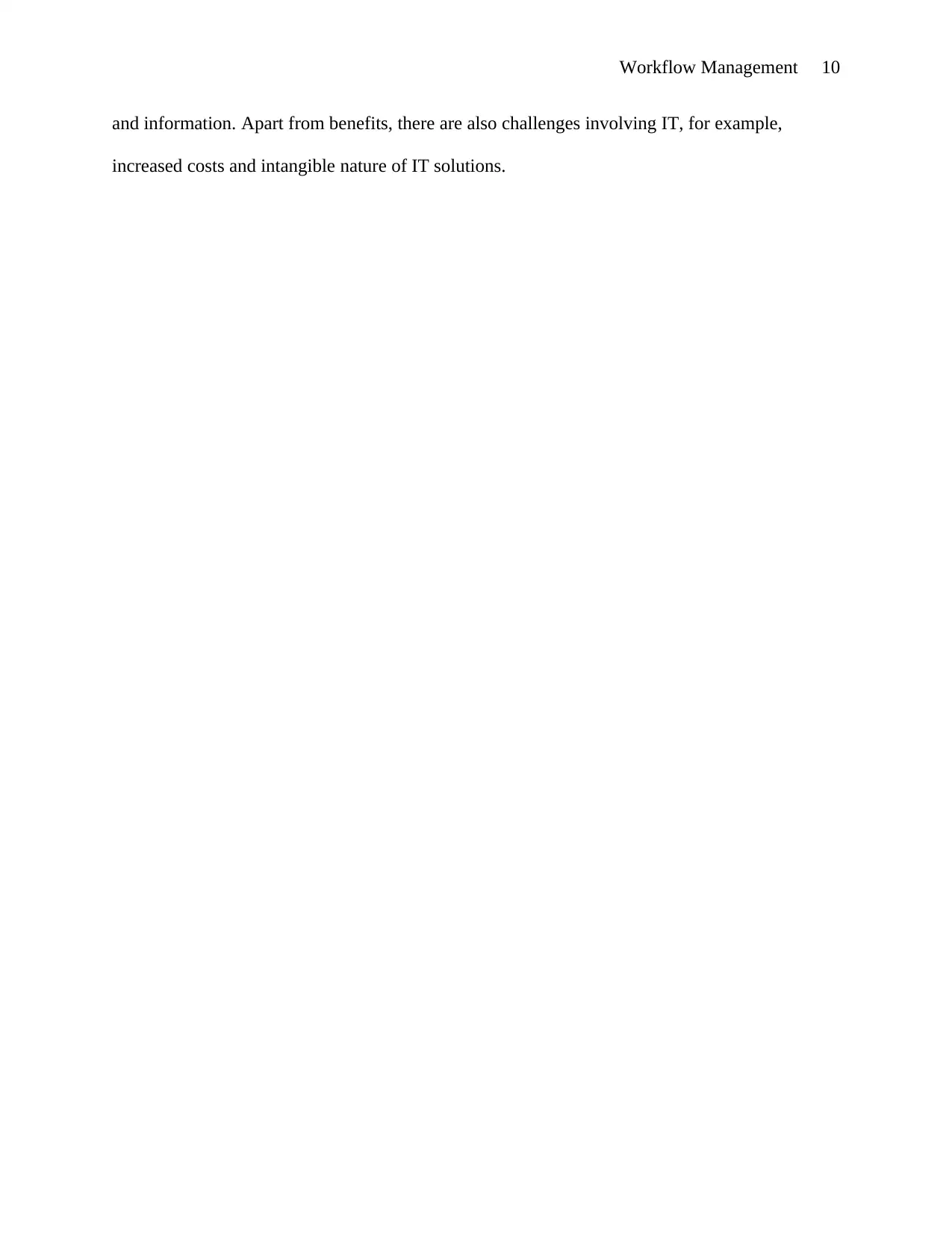
Workflow Management 10
and information. Apart from benefits, there are also challenges involving IT, for example,
increased costs and intangible nature of IT solutions.
and information. Apart from benefits, there are also challenges involving IT, for example,
increased costs and intangible nature of IT solutions.
Paraphrase This Document
Need a fresh take? Get an instant paraphrase of this document with our AI Paraphraser
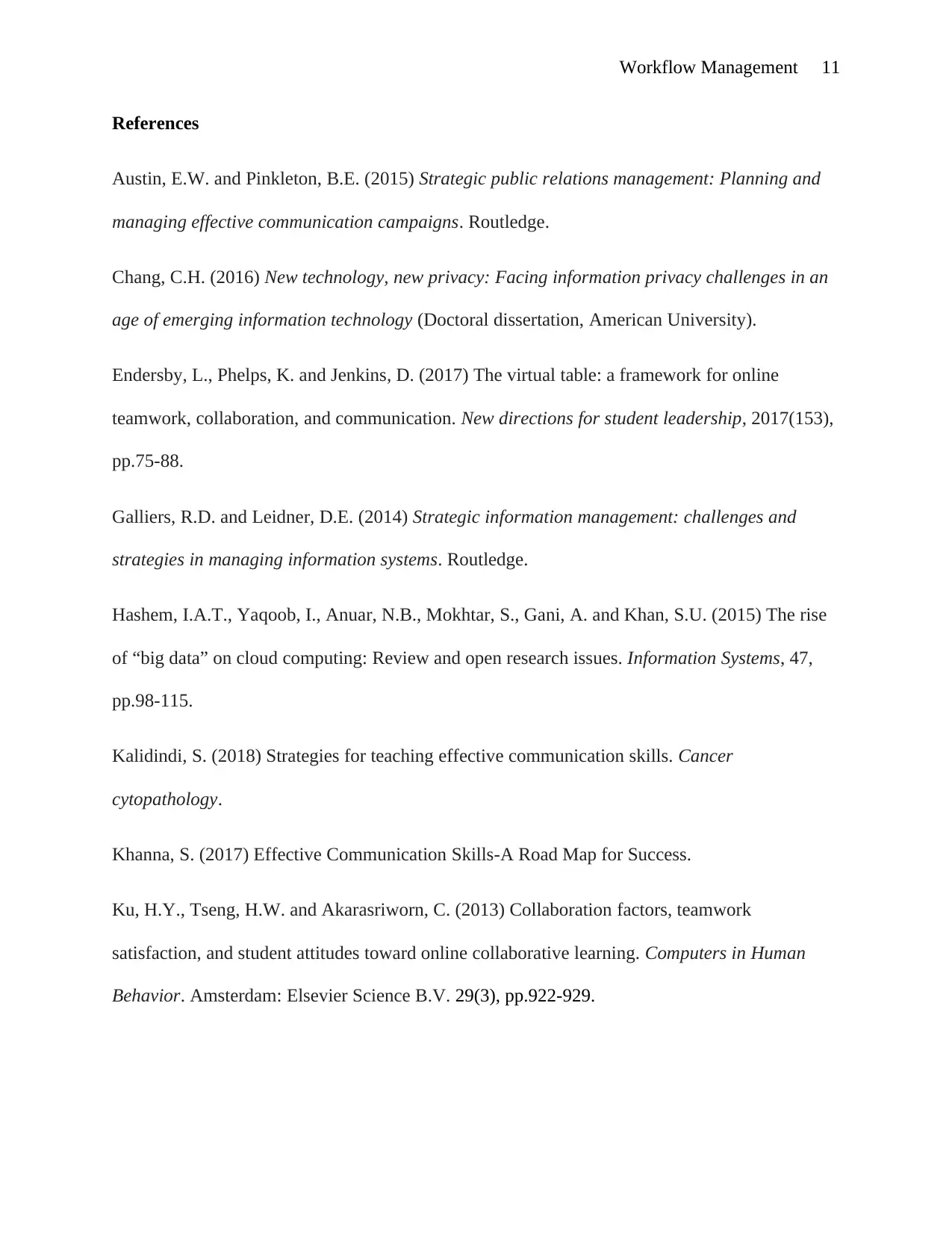
Workflow Management 11
References
Austin, E.W. and Pinkleton, B.E. (2015) Strategic public relations management: Planning and
managing effective communication campaigns. Routledge.
Chang, C.H. (2016) New technology, new privacy: Facing information privacy challenges in an
age of emerging information technology (Doctoral dissertation, American University).
Endersby, L., Phelps, K. and Jenkins, D. (2017) The virtual table: a framework for online
teamwork, collaboration, and communication. New directions for student leadership, 2017(153),
pp.75-88.
Galliers, R.D. and Leidner, D.E. (2014) Strategic information management: challenges and
strategies in managing information systems. Routledge.
Hashem, I.A.T., Yaqoob, I., Anuar, N.B., Mokhtar, S., Gani, A. and Khan, S.U. (2015) The rise
of “big data” on cloud computing: Review and open research issues. Information Systems, 47,
pp.98-115.
Kalidindi, S. (2018) Strategies for teaching effective communication skills. Cancer
cytopathology.
Khanna, S. (2017) Effective Communication Skills-A Road Map for Success.
Ku, H.Y., Tseng, H.W. and Akarasriworn, C. (2013) Collaboration factors, teamwork
satisfaction, and student attitudes toward online collaborative learning. Computers in Human
Behavior. Amsterdam: Elsevier Science B.V. 29(3), pp.922-929.
References
Austin, E.W. and Pinkleton, B.E. (2015) Strategic public relations management: Planning and
managing effective communication campaigns. Routledge.
Chang, C.H. (2016) New technology, new privacy: Facing information privacy challenges in an
age of emerging information technology (Doctoral dissertation, American University).
Endersby, L., Phelps, K. and Jenkins, D. (2017) The virtual table: a framework for online
teamwork, collaboration, and communication. New directions for student leadership, 2017(153),
pp.75-88.
Galliers, R.D. and Leidner, D.E. (2014) Strategic information management: challenges and
strategies in managing information systems. Routledge.
Hashem, I.A.T., Yaqoob, I., Anuar, N.B., Mokhtar, S., Gani, A. and Khan, S.U. (2015) The rise
of “big data” on cloud computing: Review and open research issues. Information Systems, 47,
pp.98-115.
Kalidindi, S. (2018) Strategies for teaching effective communication skills. Cancer
cytopathology.
Khanna, S. (2017) Effective Communication Skills-A Road Map for Success.
Ku, H.Y., Tseng, H.W. and Akarasriworn, C. (2013) Collaboration factors, teamwork
satisfaction, and student attitudes toward online collaborative learning. Computers in Human
Behavior. Amsterdam: Elsevier Science B.V. 29(3), pp.922-929.
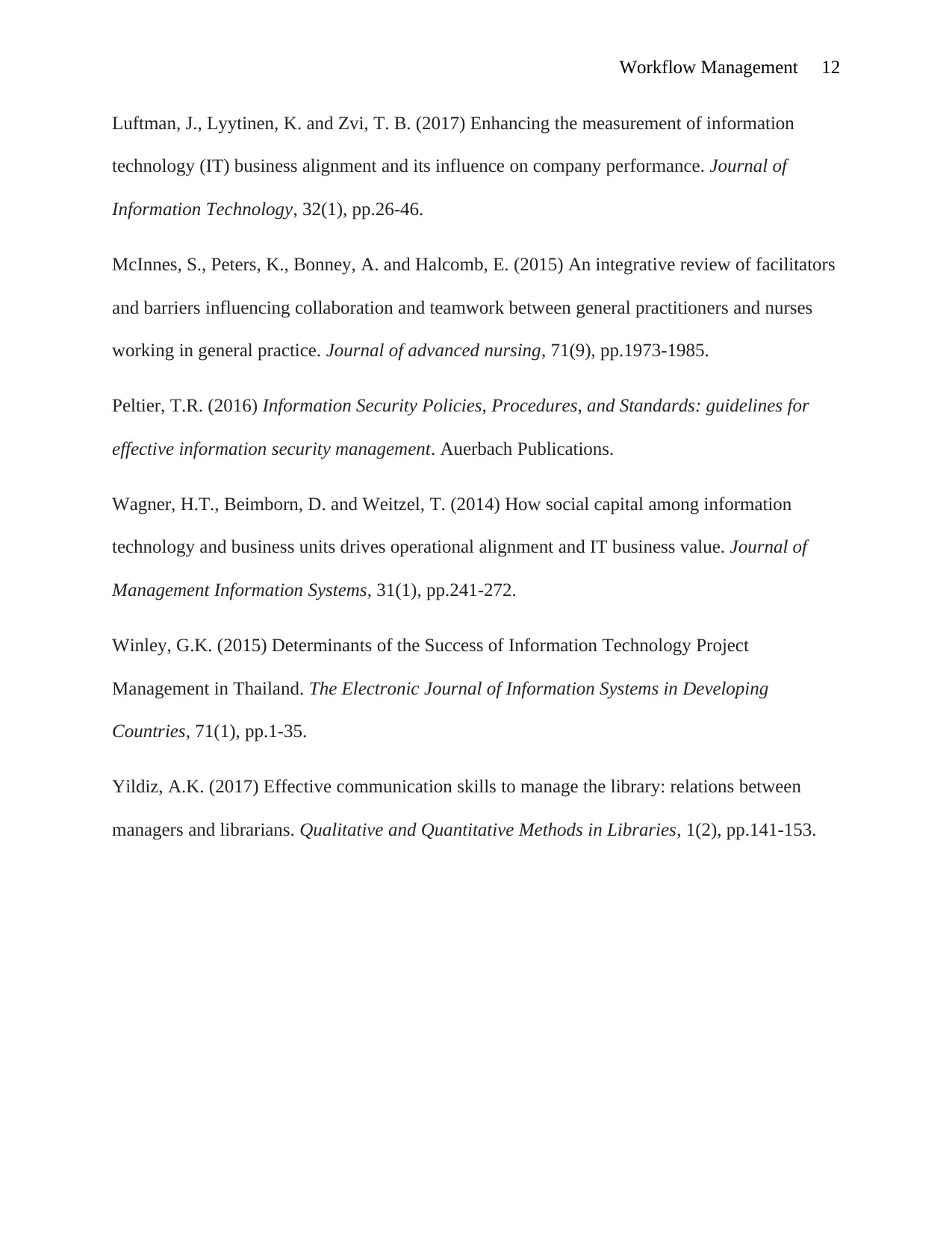
Workflow Management 12
Luftman, J., Lyytinen, K. and Zvi, T. B. (2017) Enhancing the measurement of information
technology (IT) business alignment and its influence on company performance. Journal of
Information Technology, 32(1), pp.26-46.
McInnes, S., Peters, K., Bonney, A. and Halcomb, E. (2015) An integrative review of facilitators
and barriers influencing collaboration and teamwork between general practitioners and nurses
working in general practice. Journal of advanced nursing, 71(9), pp.1973-1985.
Peltier, T.R. (2016) Information Security Policies, Procedures, and Standards: guidelines for
effective information security management. Auerbach Publications.
Wagner, H.T., Beimborn, D. and Weitzel, T. (2014) How social capital among information
technology and business units drives operational alignment and IT business value. Journal of
Management Information Systems, 31(1), pp.241-272.
Winley, G.K. (2015) Determinants of the Success of Information Technology Project
Management in Thailand. The Electronic Journal of Information Systems in Developing
Countries, 71(1), pp.1-35.
Yildiz, A.K. (2017) Effective communication skills to manage the library: relations between
managers and librarians. Qualitative and Quantitative Methods in Libraries, 1(2), pp.141-153.
Luftman, J., Lyytinen, K. and Zvi, T. B. (2017) Enhancing the measurement of information
technology (IT) business alignment and its influence on company performance. Journal of
Information Technology, 32(1), pp.26-46.
McInnes, S., Peters, K., Bonney, A. and Halcomb, E. (2015) An integrative review of facilitators
and barriers influencing collaboration and teamwork between general practitioners and nurses
working in general practice. Journal of advanced nursing, 71(9), pp.1973-1985.
Peltier, T.R. (2016) Information Security Policies, Procedures, and Standards: guidelines for
effective information security management. Auerbach Publications.
Wagner, H.T., Beimborn, D. and Weitzel, T. (2014) How social capital among information
technology and business units drives operational alignment and IT business value. Journal of
Management Information Systems, 31(1), pp.241-272.
Winley, G.K. (2015) Determinants of the Success of Information Technology Project
Management in Thailand. The Electronic Journal of Information Systems in Developing
Countries, 71(1), pp.1-35.
Yildiz, A.K. (2017) Effective communication skills to manage the library: relations between
managers and librarians. Qualitative and Quantitative Methods in Libraries, 1(2), pp.141-153.
⊘ This is a preview!⊘
Do you want full access?
Subscribe today to unlock all pages.

Trusted by 1+ million students worldwide
1 out of 12
Related Documents
Your All-in-One AI-Powered Toolkit for Academic Success.
+13062052269
info@desklib.com
Available 24*7 on WhatsApp / Email
![[object Object]](/_next/static/media/star-bottom.7253800d.svg)
Unlock your academic potential
Copyright © 2020–2025 A2Z Services. All Rights Reserved. Developed and managed by ZUCOL.




